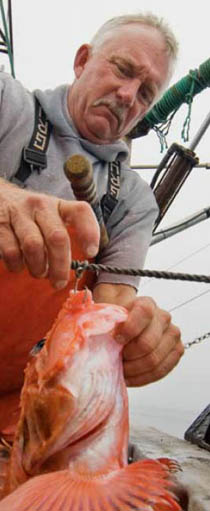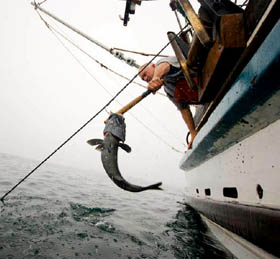Morro Bay is a picturesque coastal community in central California. The town’s most prominent physical feature is Morro Rock, the remnant of an ancient volcano, which stands at the entrance to the bay that gives the town its name. This small bay is home to a fleet of trawlers that target petrale sole, sand dabs, sablefish, and other groundfish. With an overcapitalized fleet and declining fish stocks, Morro Bay’s commercial fishing industry has suffered economically over the past two decades. This is a part of a widespread trend—between 1987 and 2003 gross revenues from Pacific groundfish trawling fell by two-thirds.
Worsening the situation, commercial trawling has come under increasing criticism for its negative environmental effects. Bottom trawling involves dragging large, weighted nets across the seafloor, which can harm corals and rocky bottom structures. Avoiding sensitive habitats or using different gear can minimize these damages, but existing regulations provide no incentives to practice such safeguards.
Bycatch, the incidental take of non-commercial species, is an additional environmental concern in this fishery and in trawl fisheries in general due to the nonselective nature of commercial trawling. By one estimate, 26 percent of the world’s entire commercial catch is discarded each year. Fortunately, bycatch is far less severe in the area in question and there are abundant stocks of many of the target species. The main problem is to catch target stocks more selectively, so as to avoid a few overfished species such as canary and yelloweye rockfish, and cowcod. Under existing regulations, the entire fishery is closed if incidental catch of a depleted species exceeds a regulatory limit. Unfortunately, the same regulations provide no reason for individual fishers to minimize bycatch, so bycatch-induced closures have been common.
Collaborate or Collapse
The local community identifies with the commercial fishing industry, regards it as an important factor in the town’s appeal to visitors, and is anxious to keep it economically viable. With bleak economic prospects and growing environmental concerns, however, the future of commercial fishing in Morro Bay is uncertain at best
With an overcapitalized fleet and declining fish stocks, Morro Bay’s commercial fishing industry has suffered economically over the past two decades.
These problems can be compared to land-use conflicts, where economically valuable activities such as ranching and farming conflict with the conservation of sensitive habitats and the flora and fauna they support. Conservation organizations often find, however, that they can achieve their goals by negotiating voluntary agreements in which landowners receive compensation for modifying the way they use their land. These agreements, called conservation easements, sometimes prohibit “negative” actions such as residential development, logging woodlands, or farming near streams, or mandate “positive” practices such as providing recreational access to property. Conservation easements typically apply in perpetuity and bind future owners. As of 2005, the acreage under conservation easements in the United States stood at 7.8 million acres, an area roughly the size of Maryland.
Conservation easements have certain advantages over legislated land-use regulations as a strategy for achieving conservation. Because they are voluntary and provide compensation, they do not work against the landowner’s interests, which can be a political advantage in gaining adoption. In addition, they are flexible and can be tailored to the attributes of individual parcels; land-use regulations typically must be applied uniformly. Importantly, the original owner maintains possession and the original economic use of the land often continues, so the economic benefits of the owner’s specialized knowledge are not lost.
Using conservation easements to protect the ocean environment seems like a non-starter because there is no property owner with whom to negotiate. However, commercial fishing permits do delineate rights to use the marine environment in specified ways and this raises the possibility of negotiating a conservation easement on the permit. Under such an agreement, the permit holder would cede rights to some actions that are legal but environmentally damaging, in return for compensation. Intuitively, this approach to conservation works better when existing permits clearly define the right to use the resource.
Trio of Unlikely Partners
The Nature Conservancy’s (TNC) conservation goals for the central California ground fishery were to change the method of fishing from bottom trawling to less damaging trap and hook and line gear and to exclude commercial trawling from sensitive habitats. Existing regulations made it impossible to negotiate easements that would stipulate these conditions on the trawl permit directly, necessitating the use of a less direct strategy. 
The Nature Conservancy and EDF also wished to greatly reduce trawl effort on sensitive habitats, an outcome that required regulatory action by the Pacific Fishery Management Council. Illustrating a key advantage of the voluntary easement approach, TNC and EDF gained the support of Morro Bay fishers and the local community by agreeing to buy back trawl permits and vessels from any who wished to sell if the no-trawl zone was adopted. With conservation, community, and fishing interests arguing in favor of the closure, the effort was successful. The outcome is a no-trawl zone of some 3.8 million acres.
Another important advantage of the easement approach is flexibility in adapting individual agreements to specific circumstances and latitude for experimenting with different conservation approaches. These features allowed TNC to negotiate a “conservation fishing agreement” with Morro Bay fisherman Ed Ewing, using one of the vessels it purchased in 2006. The vessel and permit lease agreement specified geographic, monitoring, and gear restrictions. Using available science, TNC developed a geographic plan that focuses effort on soft bottom seafloor that had been heavily trawled for many years, while avoiding sensitive hard bottom areas. The monitoring component included tracking by a Vessel Monitoring System, extensive use of observers, and collection of fishing log and fish ticket data. In addition, the gear used is both smaller and lighter than traditional deep water trawl nets.
Beyond Morro Bay
Early signs of success from Morro Bay led TNC to try a similar experiment in Half Moon Bay, a coastal community to the north. One permit holder based there had long used Scottish seine gear instead of bottom trawl nets to harvest sand dabs and petrale sole. This alternative method catches bottom fish in a more environmentally friendly manner than traditional trawling— making the catch particularly attractive to buyers in the San Francisco Bay area. Scottish seining does not require the heavy doors and cables used with traditional trawling and the lighter gear and gentle retrieval process dramatically reduce sea floor degradation. This method has also been shown to result in low bycatch rates. To ensure that this practice continues, TNC negotiated with the individual to purchase the permit and then leased it back with the stipulation that the use of Scottish seine gear continue and with some geographic restrictions on areas fished.
There is a reason to hope that marine conservation easements will become a widespread tool for ocean conservation in the future.
The Nature Conservancy regards its first year of commercial fishing with these permits and restricted lease conditions as a success. Six of the permits it owns were granted an ‘exempted fishing permit’ by regulators, which allowed the desired gear switching. The voluntary, contractual approach to marine protection is supported by the participating fishers and the local community, and has been approved by the regulators. It has also demonstrated broad scope for flexibility and experimentation. The environmental interests involved regard it as a promising way to reduce bycatch and to reduce seafloor damage. In light of these achievements, and compared to the torturous task of pursuing environmental protection through regulatory change, there is reason to hope that marine conservation easements will become a widespread tool for ocean conservation in the future.
Special thanks to the Nature Conservancy and Bridget Besaw for the generous donation of the Morro Bay photographs for this article. See interview and slideshow feature at nature.org/wherewework/northamerica/states/ maine/news/news2679.html.



